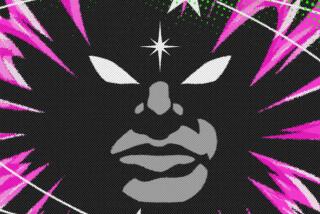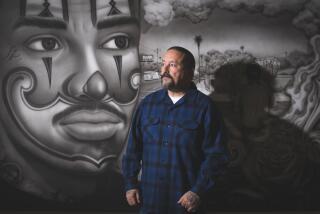Dilbert’s Creator Promoted to Top Dog, and That Ain’t Peanuts
- Share via
As Dilbert might put it, the performance-management task force offered input to the peer review study group, which sent its recommendation to the strategic planning committee, which compiled the final report.
There was simply no way that cartoonists picking the year’s top comic strip could merely toss names in a hat--and then draw the winner.
Members of the National Cartoonists Society who gathered Saturday night in Pasadena named Scott Adams winner of the Reuben award, cartooning’s highest honor. And Adams’ daily comic “Dilbert” was picked as the year’s top newspaper strip.
It was serious work for those with the nation’s most frivolous-looking job: filling the funny pages.
Although the number of newspapers in this country continues to decline, the 600-member cartoonists group has never been larger. The array of issues facing the organization has never been larger either.
Should cartoonists who work out of their homes be required to pay state or local taxes on drawings they send to out of town publications?
Should magazines buying gag panels pay with special checks that force cartoonists to sign away all rights to their work as they endorse the check and cash it?
Should artists be forced to cower beneath their drawing boards if companies they parody in cartoons send lawyers to muzzle them?
That last dilemma was faced by society leaders as they organized this year’s three-day movie-themed cartoonists convention, which ends today at the Ritz-Carlton Huntington hotel.
When Patrick McDonnell drew a whimsical convention logo reminiscent of the MGM studio symbol, using cartoon creatures from his “Mutts” newspaper strip in place of the famed roaring lion, MGM lawyers dashed off a cease-and-desist order.
Metro-Goldwyn-Mayer refused to budge when society past President Mell Lazarus pleaded for permission to give convention-goers T-shirts and goody bags that had already been imprinted with the cartoon logo.
It cost $3,000 to redesign and reprint the shirts and bags at the last minute, according to Lazarus, a Woodland Hills resident and former Reuben winner whose comic strip “Momma” appears nationwide.
Cartoonists attending a convention seminar on their legal rights suggested that companies’ lawyers seem to be among the most dedicated readers of the comics page.
Melrose, Mass. cartoonist Mark Parisi said he received a cease-and-desist letter from the La-Z-Boy Co. when he depicted a reclining chair in one of his “Off the Mark” panels.
Other discussions dealt with cartoonists’ opportunities to replace pens and paper with touch pads and computers, and whether cartoonists should charge fans for autographs, as sports figures do (Mort Walker of “Beetle Bailey” argued yes, Charles Schulz of “Peanuts” argued no).
Daryl Cagle, a Woodland Hills cartoonist who draws the “True” panel, outlined the society’s campaign to limit local taxation of cartoonists’ work. That effort includes cartoonist-sponsored legislation (Senate Bill 664) that seeks to exempt caricature artists from a California art tax.
Along with the recipient of the Reuben--named after legendary cartoonist Rube Goldberg--other cartoon winners announced Saturday night were David Gantz, best newspaper panel; Bob Staake, best newspaper illustration; Glenn McCoy, editorial cartoons; Don Perlin, comic books; B.B. Sams, advertising and illustration; Nik Ranieri, feature animation; David Feiss, television animation; Guy Gilchrist, magazine and book illustration; Mark Tonra, gag cartoons; and Dave Coverly, greeting cards.
These are boom times for many cartoonists--especially animators and those with Internet ties. Newspaper cartoonists whose strips are spun off into television shows and toy lines also attract plenty of attention from artists hoping to break into the business.
But with only about 300 comic strips and panels being published regularly in this country, it’s not easy. Jay Kennedy, editor-in-chief of King Features Syndicate, said he receives submissions from 6,000 cartoonists annually. But he only signs up three newcomers a year.
To be noticed, fledgling cartoonists need to draw characters that are unique, said George Breisacher, a Charlotte (N.C.) Observer staff artist who is the society’s current president.
“The opportunities are enormous,” he said. “But in 1998 you have to be different. The kiss of death is being the same.”
Glendale cartoonist Steve Moore agreed. He was working as a newspaper copy editor when he launched his “In the Bleachers” panel a dozen years ago. Moore said he picked a sports theme to avoid “trying to compete with the ‘Far Side’ clones,” which at the time were mimicking the style of cartoonist Gary Larson.
Reuben winner Adams said those interested in cartooning should likewise center panels or strips around specialized themes. Readers have expressed interest in panels about “tech support people, or going to school--college in particular,” he said.
“The days of just having a nice, sweet little strip and successfully launching it are over,” said Adams, a Bay Area resident who was a Pacific Bell applications engineer when he created “Dilbert” nine years ago. He said his strip took off after readers wrote to suggest that it adopt more of a business theme. “It wasn’t exactly what I wanted to do, but it worked,” he said.
Seen in 1,700 newspapers, “Dilbert” came to The Times after the newspaper’s Business section took notice of its theme and requested it, according to Times comics editor Nancy Tew. The newspaper, which publishes 47 comics daily, normally relies on a committee to help sketch out its list of which ones to print.
More to Read
The biggest entertainment stories
Get our big stories about Hollywood, film, television, music, arts, culture and more right in your inbox as soon as they publish.
You may occasionally receive promotional content from the Los Angeles Times.











